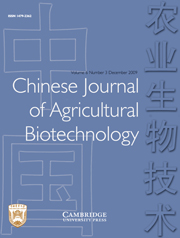No CrossRef data available.
Article contents
Cloning of the obese gene (ob) of adipose tissue, and differences in ob gene expression with age of piglets
Published online by Cambridge University Press: 12 February 2007
Abstract
Genomic RNA was extracted from the subcutaneous adipose tissue of piglets (Duroc×Landrace×Tai-hu) at 1, 14, 28, 42 and 56 days of age, and obese gene (ob) mRNA was amplified using reverse transcriptase-polymerase chain reaction (RT-PCR). A DNA fragment of about 504 bp was obtained and the PCR product was cloned into a pGEM-T vector. The ob gene was isolated and sequenced from the positive clones screened. Sequence analysis suggested that this fragment was a partial sequence of ob cDNA, coding 167 amino acid residues, which constituted the major part of leptin mature protein. The gene homology of the fragment obtained in this study compared to the reported ob cDNA sequence in adipocytes of pig was 99.405%, and amino acid homology was 98.94%. Based on the ob gene clone, we successfully constructed an optimal semi-quantitative RT-PCR method. Using β-actin as the internal control, we investigated the difference of ob gene expression at different ages of piglets. Results showed that ob mRNA levels increased steadily at postnatal days 1–28 (preweaning), peaked at postnatal day 28, when piglets were weaned, and decreased from day 28 to 56.
- Type
- Research Article
- Information
- Copyright
- Copyright © China Agricultural University and Cambridge University Press 2005


